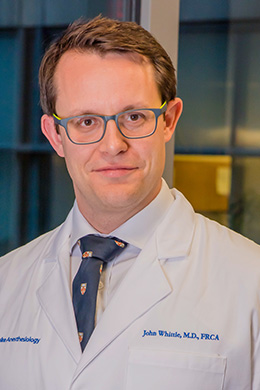 John Whittle, MD
John Whittle, MD
Consultant in Anaesthesia, Perioperative & Critical Care Medicine
University College London Hospitals;
Associate Professor in Perioperative Medicine
Centre for Perioperative Medicine,
Department of Targeted Intervention,
Division of Surgery and Interventional Sciences
University College London
London, England
Dr. Whittle’s Research
Preoperative exercise to improve vagal tone (PREVENT) study
Post-operative morbidity is a significant public health burden and is associated with reduced quality of life and mortality. Impaired preoperative aerobic exercise capacity is strongly associated with established inflammation, an increased inflammatory response to surgical trauma, mitochondrial dysfunction and the development of postoperative complications. The mechanisms underlying these associations are not currently established. Parasympathetic Autonomic Dysfunction (PAD) is one potential unifying mechanism for these relationships. PAD is common in aerobically unfit individuals and in older surgical patients. It is associated with an established inflammatory phenotype, mitochondrial dysfunction and an increased risk of intraoperative and perioperative morbidity. Aerobic exercise training can improve parasympathetic function in older and multimorbid patients and is a promising non-invasive intervention to reduce perioperative risk. We will employ an effective four- week supervised preoperative aerobic exercise training protocol in older surgical patients listed for major abdominal surgery. Using established laboratory techniques, we will assess baseline and post-intervention parasympathetic autonomic function, aerobic exercise capacity, inflammatory biomarkers and markers of cellular mitochondrial function in anticipation of a greater understanding of mechanisms underlying the development of perioperative morbidity and in anticipation of the development of strategies to enhance perioperative organ protection through the modulation of parasympathetic activity. This project is of direct relevance to the field of anesthesiology by addressing the modification of an underexplored mechanistic pathway (autonomic dysfunction) for the development of postoperative complications.
Related Publications
Implementation of a surgical prehabilitation pathway at a tertiary surgical centre during a global pandemic
Heung-Yan Wong, Lorna Starsmore, Nicholas Tetlow, Kassie Montanheiro, Uta Bellin, John Whittle
Prehabilitation is the process of enhancing a patient’s functional capacity before a stressful event such as major surgery. By allowing patients to ‘wait well’, prehabilitation has been proposed as one intervention able to transform the preoperative period into active preparation time. In addition, owing to prolonged surgical waiting times because of the COVID-19 pandemic, recommendations for prehabilitation have begun to appear in guidelines around preparation for surgery. In this context, the authors set out to develop a new prehabilitation service in a tertiary referral centre with a dispersed geographical referral space.
Objective assessment of metabolism and guidance of ICU rehabilitation with cardiopulmonary exercise testing
John Whittle, Iñigo San-Millán
Addressing the reduced quality of life that affects ICU survivors is the most pressing challenge in critical care medicine. In order to meet this challenge, we must translate lessons learnt from assessing and training athletes to the clinical population, utilizing measurable and targeted parameters obtained during cardiopulmonary exercise testing (CPET). Recent findings indicate that critical illness survivors demonstrate a persistent reduction in their physical and metabolic function. This manifests in reduced aerobic exercise capacity and metabolic inflexibility. CPET-guided targeted metabolic conditioning has proved beneficial in several clinical populations, including those undergoing high-risk surgery, and could be successfully applied to the rehabilitation of ICU survivors. CPET shows great promise in the guidance of rehabilitation in functionally limited ICU survivors. Parallels in the physiological response to exercise in athletes and clinical populations with the stress and consequences of critical illness must be investigated and ultimately applied to the burgeoning population of ICU survivors in order to treat the consequences of survival from critical illness.
International Anesthesia Research Society
